Discover 20 hidden attractions, cool sights, and unusual things to do in Terre Haute (United States). Don't miss out on these must-see attractions: Highland Lawn Cemetery, Vigo County Courthouse, and Memorial Stadium. Also, be sure to include Eugene V. Debs Home in your itinerary.
Below, you can find the list of the most amazing places you should visit in Terre Haute (Indiana).
Table of Contents
Highland Lawn Cemetery

Cemetery in Terre Haute, Indiana. Highland Lawn Cemetery is a city-owned rural cemetery in Terre Haute, Indiana. Opened in 1884, the cemetery includes 139 acres.
The cemetery features a Richardsonian Romanesque chapel built by architect Jesse A. Vrydaugh in 1893 for a cost of $10,000. In the 1980s, the chapel underwent renovation which was completed in March 1988. Highland Lawn also includes a bell tower built by the Heidenreich Company in 1894, a gateway arch completed by Edward Hazledine and a Colonial rest house designed by W.H. Floyd.
Highland Lawn was placed on the National Register of Historic Places in 1990 for its significance in agriculture and landscaping.[1]
Vigo County Courthouse
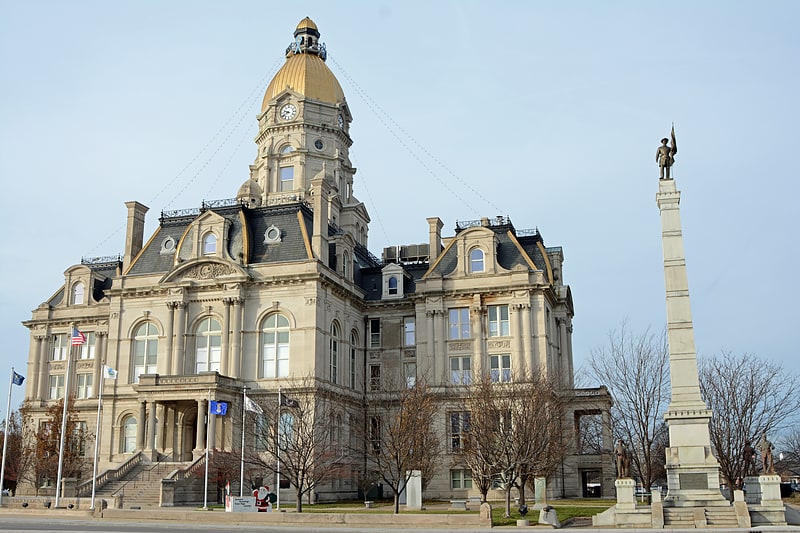
Courthouse. The Vigo County Courthouse is a courthouse in Terre Haute, Indiana. The seat of government for Vigo County, the courthouse was placed on the National Register of Historic Places in 1983.[2]
Address: Terre Haute, 33 So.3rd St
Memorial Stadium
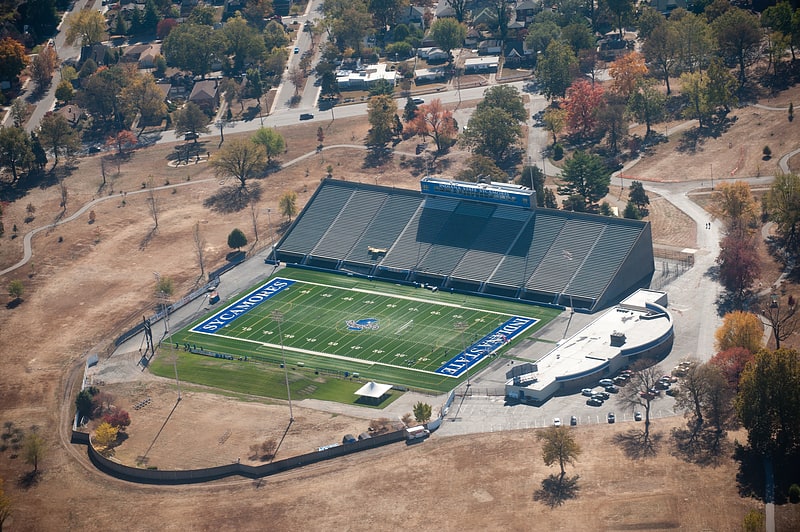
Stadium in Terre Haute, Indiana. Memorial Stadium is the current home of the Indiana State Sycamores football and soccer section in Terre Haute, Indiana, United States. The stadium was renovated between 1967 and 1969; it was built to host professional minor league baseball; the Indiana State football team began playing there in 1949.[3]
Address: 3300 Wabash Ave, 47803-1602 Terre Haute
Eugene V. Debs Home
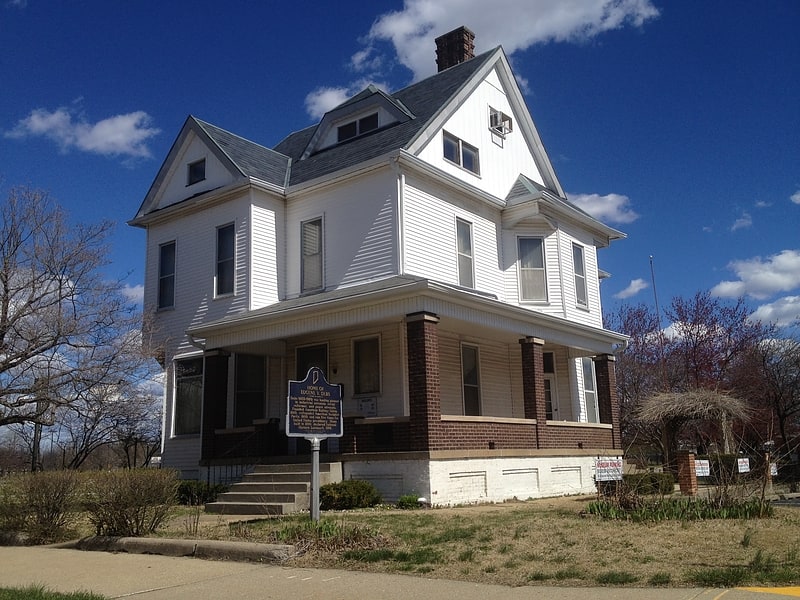
Home in Terre Haute, Indiana. The Eugene V. Debs House, on the campus of Indiana State University in Terre Haute, Indiana, was a home of union leader Eugene V. Debs. It was declared a National Historic Landmark in 1966. The museum is maintained by the Eugene V. Debs Foundation, a non-profit educational foundation.
Eugene V. Debs and his wife, Kate, built the two-story frame house in 1890, after their fifth wedding anniversary. Debs was criticized for the house not portraying working-class lifestyle; his wife was a beneficiary of her wealthy aunt's will and could furnish the house affluently. Visitors to Debs' house during his lifetime included friends James Whitcomb Riley and Carl Sandburg; one room in the house to this day is known as the Riley bedroom. When Debs died in 1926, a funeral sermon was given for him at the house, attended by 5000 people.
Original features of the house include the cobalt blue porcelain tile fireplace imported from Italy, the mahogany dining and parlor furniture, and the entire set of Haviland china. The house is also a museum, with many memorabilia of Debs' life and some of his personal library, much of which is across the street at the library of Indiana State University. One room is covered by murals depicting Debs' life.
After Debs' death, the house would see different owners. One was a professor at Indiana State University. It was used as the Theta Chi fraternity house from 1948 to 1961, and briefly was let as apartments. In 1962 the home was bought by the Eugene V. Debs Foundation, which continues to own the house. In 1965 it was made an official Indiana historic site by the Indiana General Assembly. In 1966 the home was made an official National Historic Landmark of the National Parks system of the Department of the Interior. Today the preservation of the property is monitored by the National Park Service. In 2004 it was removed from threatened status after sufficient repairs to the structure occurred to ensure its permanence.[4]
Address: 451 N 8th St, 47807-3006 Terre Haute
Sisters of Providence of Saint Mary-of-the-Woods
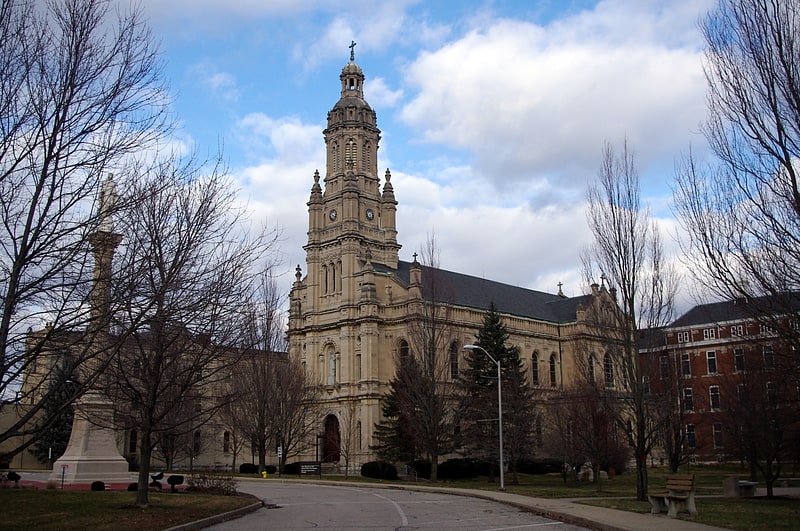
The Sisters of Providence of Saint Mary-of-the-Woods are an apostolic congregation of Catholic women founded by Saint Theodora Guerin at Saint Mary-of-the-Woods, Indiana, in 1840. Mother Theodore and her companions left the Sisters of Providence of Ruillé-sur-Loir, France, at the invitation of the Bishop of Vincennes, Indiana, to found the Sisters of Providence in the United States. In 1843, the Indiana congregation became independent of the religious institute in Ruillé, and the Rules of the Congregation were approved by the Holy See in 1887.
More than 5,200 women have entered the Sisters of Providence since 1840. As of 2014, there were nearly 350 sisters in the institute, roughly 300 of whom live and minister from the motherhouse grounds in Saint Mary-of-the-Woods, Indiana. Other sisters minister in 17 U.S. states, the District of Columbia, and Asia.
Currently, foreign missions are in Asia. Former foreign missions were in Peru and Antigua.
Sisters of Providence are designated by the initials "SP" following their name in print. The congregation is a member of the Women of Providence in Collaboration.
Mother Theodore was canonized on October 15, 2006. Her remains are located in her official shrine near the Church of the Immaculate Conception at Saint Mary-of-the-Woods, Indiana, as well as a portion buried in the Sisters of Providence Convent Cemetery.[5]
Address: 1 Providence Pl, 47876 St Mary-Of-The-Woods
Paul Dresser Birthplace
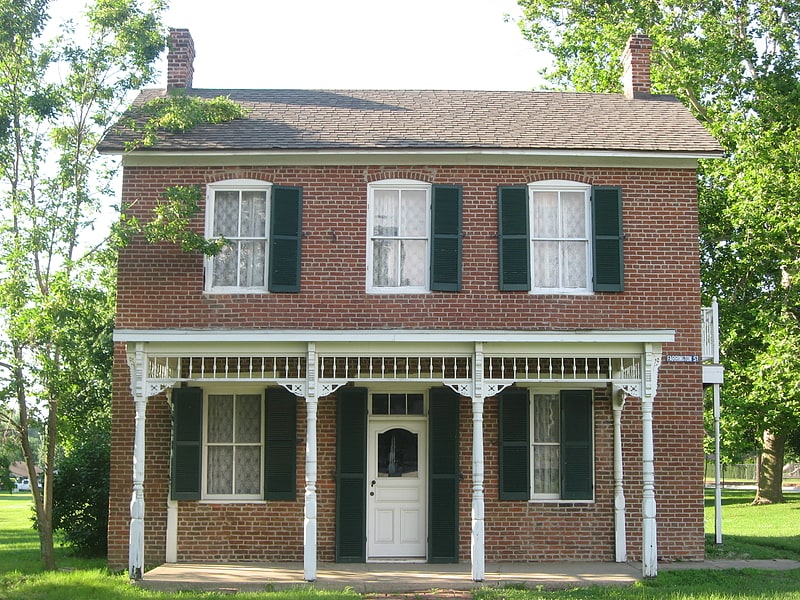
The Paul Dresser Birthplace is located in Fairbanks Park in Terre Haute, Vigo County, Indiana, at the corner of First and Farrington Streets. Listed on the National Register of Historic Places, it is the birthplace and boyhood home of Paul Dresser, a late-nineteenth-century singer, actor, and songwriter, who wrote and published more than 100 popular songs. On March 14, 1913, the Indiana General Assembly named Dresser's hit, "On the Banks of the Wabash, Far Away", the state song of Indiana.
Built in 1850, the home was owned by Dresser's parents, Johann Paul and Sarah (Schanab) Dreiser. Their son, Johann Paul Dreiser Jr. who later changed his name to Paul Dresser, was born in the house on April 22, 1858. Dresser's father built the porch for the brick house, which originally consisted of one bedroom, a lean-to kitchen, and a parlor. In 1863 Dresser's father sold the home and moved the family to Sullivan, Indiana. By 1871 they had returned to Terre Haute, but Dresser did not stay in town for long. Dresser left home at the age of sixteen and became "one of the most important composers of the 1890s". Dresser toured the country as a vaudeville entertainer, then moved to New York City, where he was also involved in music publishing. Dresser returned to Terre Haute only for brief visits and public performances.
Originally, the house was located at 318 South Second Street in Terre Haute. During the 1960s, when urban renewal threatened its demolition, the Vigo County Historical Society raised funds purchase the building, saving it from destruction, and relocated it to the southeast corner of Fairbanks Park. Altered over the years, the building consists of two floors. The first floor has a bedroom, a kitchen, and a parlor. The second floor has two bedrooms that are accessible by an outside staircase. The Vigo County Historical Society operates the home as a museum, open by appointment. Artifacts pertaining to Dresser include a Chickering piano that he used to write songs and a portrait of Dresser painted during the height of his career. Unlike other house museums, Dresser's birthplace reflects the furnishings of a working-class family, not the well-to-do.
In 1967 the Indiana General Assembly designated the home as a state shrine and memorial. That same year the National Music Council listed it as "A Landmark of American Music". The property was listed on the National Register of Historic Places in 1973. Terre Haute's Fairbanks Park also includes a local Girl Scout office and a Terre Haute parks department office. In 1923 the Banks-of-the-Wabash Association officially named Paul Dresser Drive, the park's main road, in the songwriter's honor.[6]
Collett Park
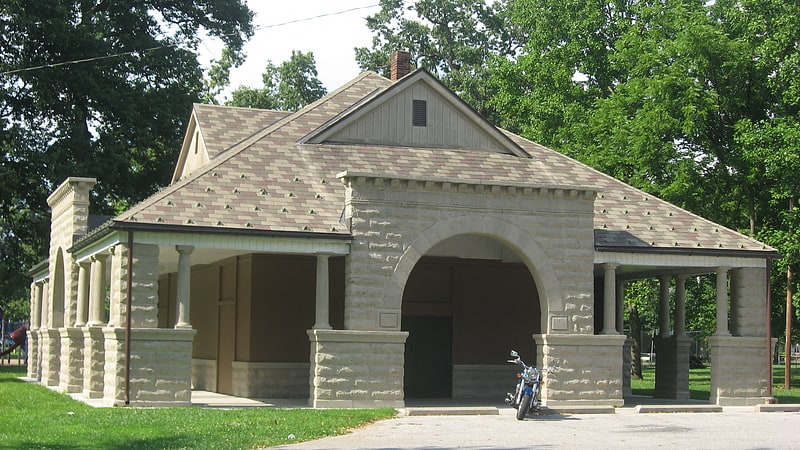
Park in Terre Haute, Indiana. Collett Park is a public park in Terre Haute, Vigo County, Indiana, United States.
The park was established in 1883 on a parcel of land donated to the city of Terre Haute by Josephus Collett, a railroad magnate and philanthropist. Its 21 acres (85,000 m2) of tree-filled park land are approximately two miles north of downtown Terre Haute. A Romanesque Revival pavilion was built in 1894 by architect J. Merrill Sherman.
The park's large main building with an indoor rental facility as well as outdoor shelters and restrooms. There are also football and soccer fields, a playground, horseshoe pits and tennis courts.
Collett Park was placed on the National Register of Historic Places in 1981 for its historical significance in entertainment and recreation. The neighborhood that arose around the park, now known as the Collett Park Neighborhood Historic District, was placed on the Register itself in 2004.[7]
Address: 7th st, 47807 Terre Haute
Indiana Theatre

Theater in Terre Haute, Indiana. The Indiana Theatre is a historic theater in Terre Haute, Indiana. It was added to the National Register of Historic Places on November 13, 1997 and is located in the Wabash Avenue-East Historic District. It opened on January 28, 1922. The theatre was built by Terre Haute resident T. W. Barhydt and was designed by John Eberson. Eberson, who later developed the atmospheric theater style of movie palace, first experimented with atmospheric design elements at the theatre. Eberson stated, "Into this Indiana Theatre I have put my very best efforts and endeavors in the art of designing a modern theatre such as I have often pictured as what I would do were I given a free hand." Through this quote Eberson suggests that the Indiana Theatre embodies the raw beginning of his experiment with a "dream" theater that marked the beginning shift to his atmospheric style.
Throughout its history, the theatre has hosted a wide range of events that have included vaudeville, cinema, performing arts and community celebrations of all types. Long time employees remember nostalgic entertainers such as Frank Sinatra, Red Skelton, Lucille Ball and Desi Arnaz, Jack Burns, and the Marx Brothers Road Shows at the Indiana Theater. The Indiana Theatre was chosen as the site for the world premiere screening of Disney's McFarland, USA on November 20, 2014.
Through restoration efforts which began in May 2013, the Indiana Theatre's heritage has been preserved and the Indiana has been reborn as a 1,600 seat full service event center which can host a wide range of community gatherings that include live entertainment, performing arts, cinema, wedding events, and fundraisers.[8]
Address: 683 Ohio St, 47807-3525 Terre Haute
Allen Chapel African Methodist Episcopal Church
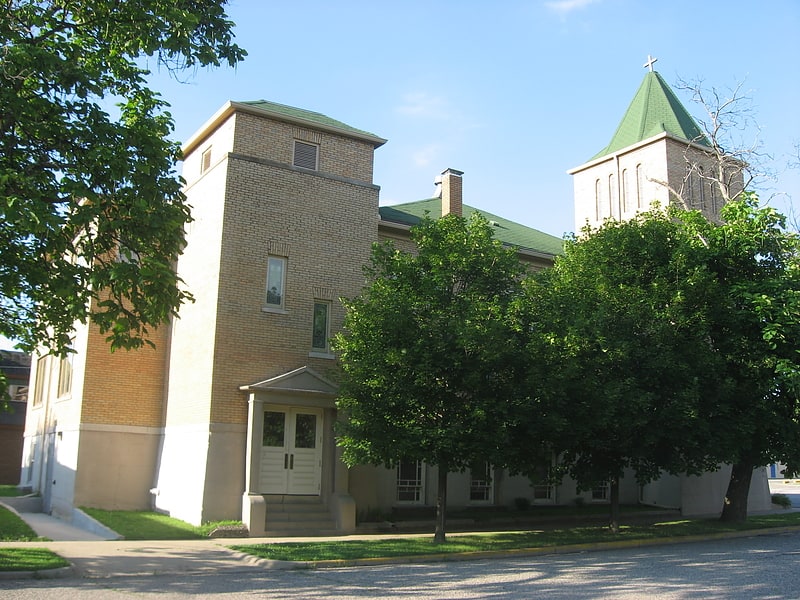
Church. Allen Chapel African Methodist Episcopal Church is a church in Terre Haute, Indiana.
The church is named for Richard Allen, who founded the African Methodist Episcopal Church in Philadelphia in 1787. The congregation in Terre Haute began meeting in 1837 in a small white church in town. This original structure had a tunnel beneath it that led to bank of the Wabash River for escaped slaves going toward Canada on the Underground Railroad. Many of the congregation's early members were freed slaves who had been brought to the area by Quakers.
In the mid-19th century, Frederick Douglass went to Terre Haute on two occasions to raise funds for the congregation. Other eminent speakers have included Eugene V. Debs and Jackie Robinson.
The current structure was built in 1913, and is a yellow brick and stone church with a prominent corner tower. It was placed on the National Register of Historic Places in 1975 for its significance in religion, social history, and African American history.[9]
Terre Haute Masonic Temple
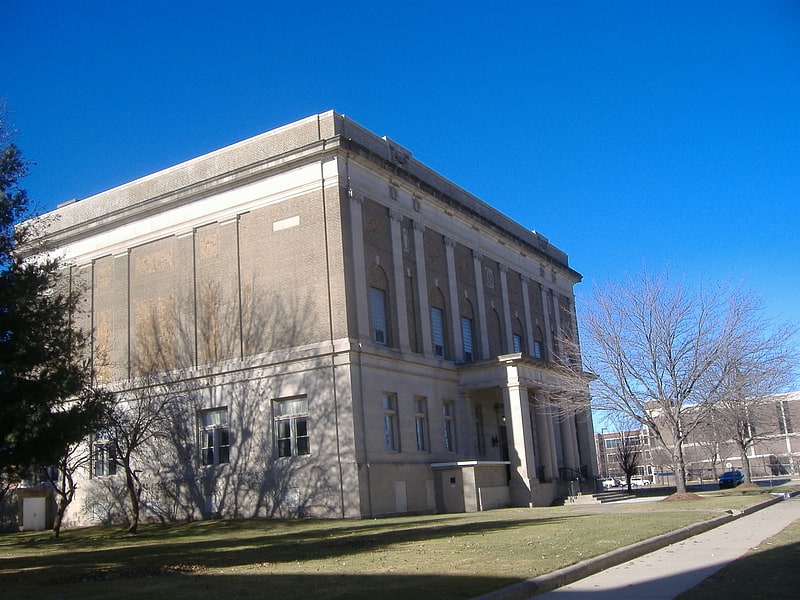
Fraternal organization in Terre Haute, Indiana. The Terre Haute Masonic Temple in Terre Haute, Indiana is a Classical Revival-style Masonic building that ground was broken for in 1915, cornerstone was laid in 1916, and opened in 1917. It was listed on the National Register of Historic Places by the United States Department of the Interior in 1995. The structure was commissioned by the Terre Haute Masonic Temple Association which was included one director from each of the following bodies that funded the building of the temple: Terre Haute Lodge No. 19, F&AM, Social Lodge No. 86 F&AM, Humboldt Lodge No. 42 F&AM, Euclid Lodge No. 573 F&AM, Terre Haute Chapter No. 11 R.A.M. Terre Haute Council No. 8 R. & S.M. Terre Haute Commandery No. 16 K.T. The Temple was built by A.W. Stoolman with Archie H. Hubbard serving as architect.
The Terre Haute Masonic Temple is currently utilized by Terre Haute Lodge No. 19, F&AM, Social Lodge No. 86 F&AM, Humboldt Lodge No. 42 F&AM, Terre Haute Chapter No. 11 R.A.M. Terre Haute Council No. 8 R. & S.M. Terre Haute Commandery No. 16 K.T. Job's Daughters Bethel No. 2, Terre Haute Chapter No. 43 Order of the Eastern Star, Terre Haute Order of Amaranth. The building was previously used by Euclid No. 573 F&AM, The Order of the White Shrine of Jerusalem and The Order of Demolay.
The governing body of the building that is responsible for all modifications and maintenance is the Terre Haute Masonic Temple Association which still includes six of the original seven bodies that erected the structure (Euclid No. 573 is no longer in existence). The board is composed of a President, Vice President, Secretary & Treasurer, and three other members.
The building is a total of four stories tall with an additional full basement. The foundation of the building was initially constructed to support the weight of a twelve-story building. The first floor is the dedicated public floor and contains the ballroom, library, parlor, board room, office, card room, and ladies and gentleman's cloak rooms and rest rooms. The second floor is dedicated to the Blue Lodge and Order of the Eastern Star and houses three lodge rooms, rest rooms and lounge area. The third floor is dedicated to the three bodies of the York Rite: The Chapter of Royal Arch Masons, Council of Royal & Secret Masters, and Commandery of Knights Templar. The fourth floor contains storage and a choir and organ loft.[10]
Address: 224 N 8th St, 47807-3110 Terre Haute
Markle House and Mill Site
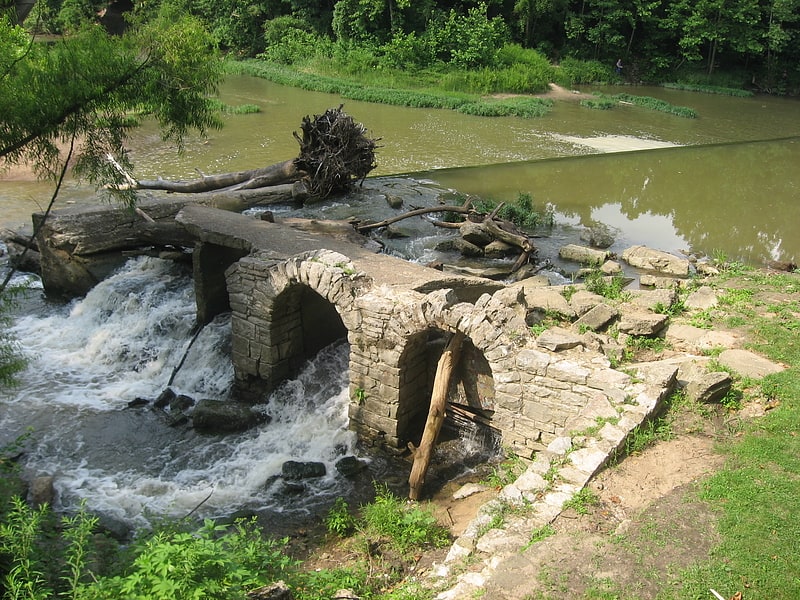
Historical landmark in Vigo County, Indiana. Markle House and Mill Site is a historic home and site of Markle's Mill located in Otter Creek Township, Vigo County, Indiana. The house was built in 1848, and is a two-story, Greek Revival style painted brick dwelling with Italianate style influences. It has a one-story, front porch with Doric order columns. The Markle's Mill burned in 1938, and the remains consist of stone and concrete foundations and the associated remains of the dam. Also on the property are the contributing outhouse and carriage house.
It was listed on the National Register of Historic Places in 1979.[11]
Hippodrome Theatre
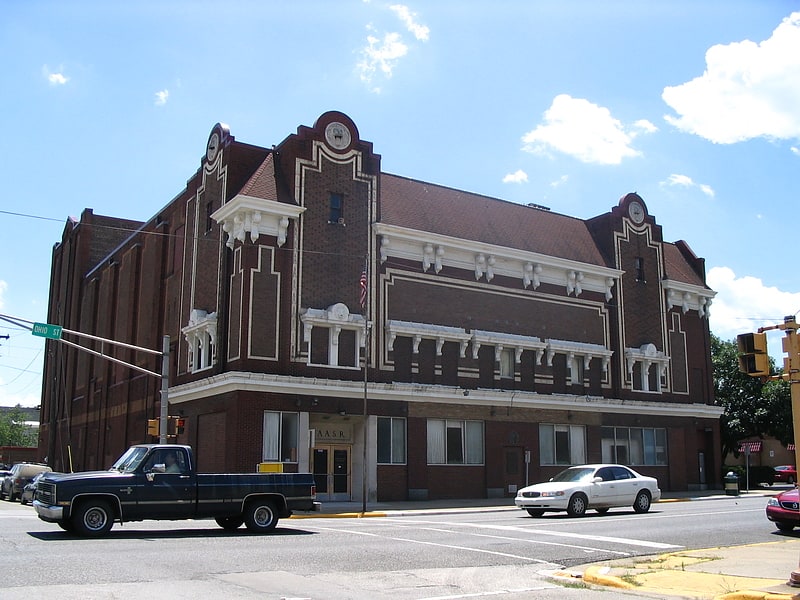
Theater in Terre Haute. The Hippodrome Theatre or Wabash Theatre is a historic theater in Terre Haute, Indiana, USA.
Theater manager Theodore W. Barhydt decided to build a theater in the area and enlisted the help of noted theater architect John Eberson to design the building. The German Renaissance structure officially opened on February 15, 1915, with a grand opening celebration attended by local dignitaries such as Indiana governor Samuel M. Ralston and vaudeville moguls like Joseph M. Finn, Marcus Heiman, and Asher Levy.
The building was placed on the National Register of Historic Places in 1983.[12]
Wabash Valley Railroad Museum
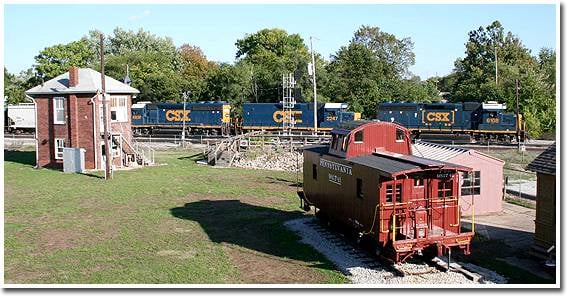
Museum, History museum, Specialty museum
Address: 1316 Plum St, 47804-4130 Terre Haute
Hawthorn Park
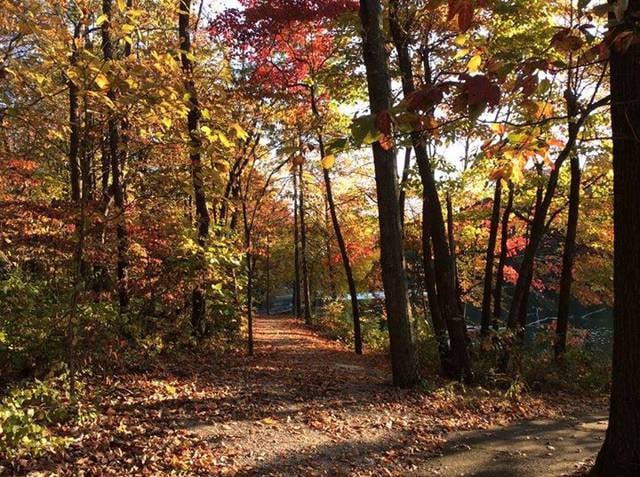
Body of water, Park, Relax in park, Hiking trail, Outdoor activities
Address: 6067 E Old Maple Ave, 47803-9526 Terre Haute
Sage-Robinson-Nagel House
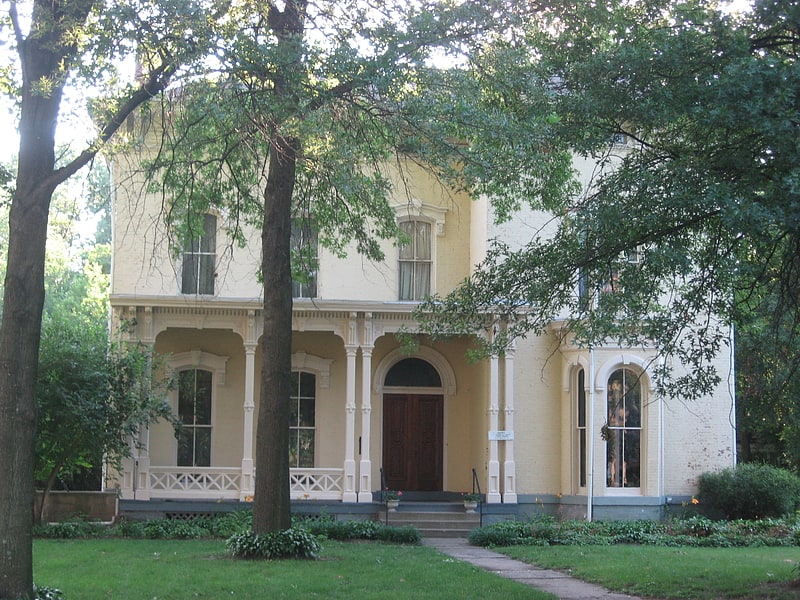
Museum in Terre Haute, Indiana. Sage-Robinson-Nagel House, also known as the Historical Museum of the Wabash Valley, is a historic home located at Terre Haute, Vigo County, Indiana. It was built in 1868, and is a two-story, "L"-shaped, Italianate style brick dwelling. It has a low-pitched hipped roof with heavy double brackets, decorative front porch, and a projecting bay window.
It was listed on the National Register of Historic Places in 1973. It is located in the Farrington's Grove Historic District.[13]
First Congregational Church
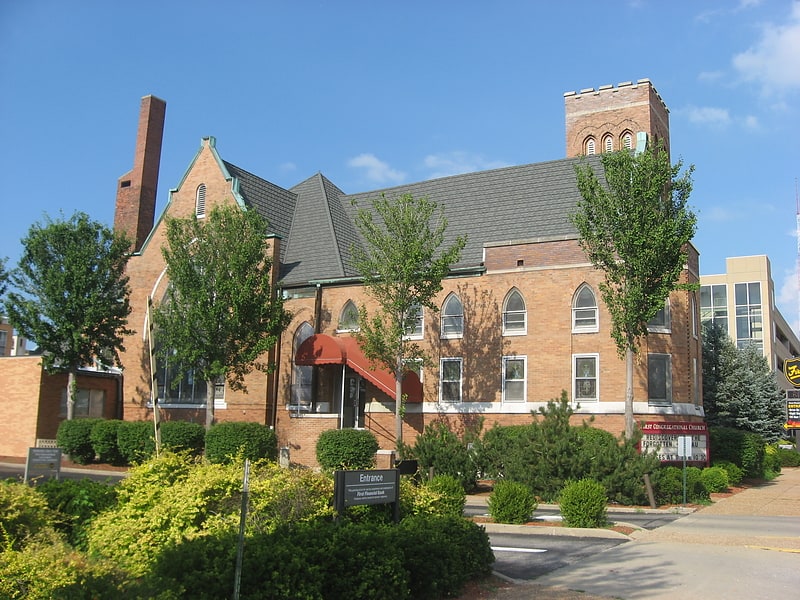
Congregational church in Terre Haute, Indiana. First Congregational Church is an historic Congregational church located at 630 Ohio Street in Terre Haute, Vigo County, Indiana. It was built in 1902-1903 and is the second building to house the congregation founded in December 1834. It is a neo-Gothic-style church constructed of buff-colored brick with limestone trim and opalescent glass windows.
FCC was added to the National Register of Historic Places in 1983.[14]
Vigo County School Corporation
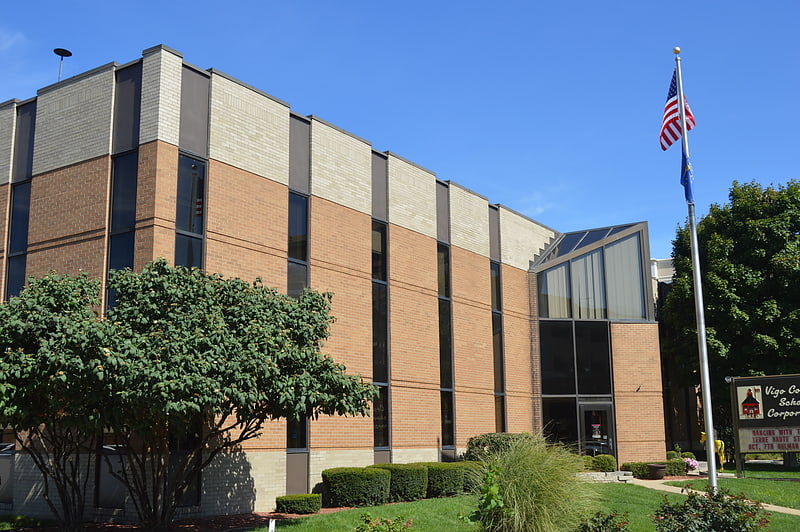
School district. Vigo County School Corporation is a school district that serves Vigo County, Indiana and is headquartered in Terre Haute. The corporation is led by superintendent Robert Haworth and by the Board of Trustees including: President; Joseph Irwin III, Vice President; Dr. Susan Powers, Secretary; Jackie Lower, Mel Burks, Paul Lockhart, Rosemarie Scott, Joni Wise. The school board holds meetings two times a month on Mondays.
The VCSC contains one building that was once a church on the National Register of Historic Places, the Woodrow Wilson Middle School building known for its Tudor Revival architecture and large-scale interior murals by Gilbert Brown Wilson.
All enrollment data is accurate for the 2020-2021 school year from the Indiana Department of Education.[15]
Address: 686 Wabash Avenue, Terre Haute
House at 823 Ohio Street

House at 823 Ohio Street is a historic home located at Terre Haute, Vigo County, Indiana. It was built in 1880, and is a two-story, rectangular brick dwelling with Italianate and Queen Anne style design elements. It features segmental arched windows and a rounded arch window with a wood sunburst surround.
It was listed on the National Register of Historic Places in 1983.[16]
Building at 810 Wabash Avenue
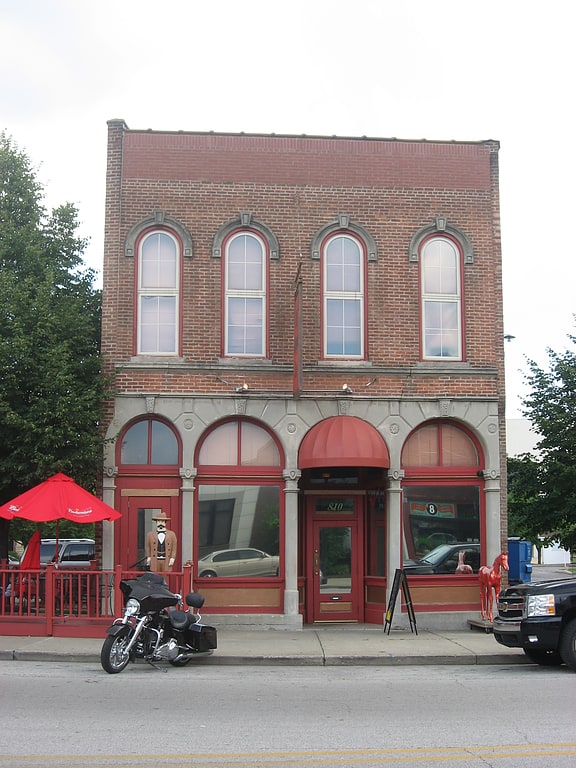
Building at 810 Wabash Avenue is a historic commercial building located at Terre Haute, Vigo County, Indiana. It was built about 1870, and is a two-story, rectangular, Italianate style brick building. It features an elaborate cast iron storefront on the first story and round arched windows on the second.
It was listed on the National Register of Historic Places in 1983.[17]
Citizens' Trust Company Building
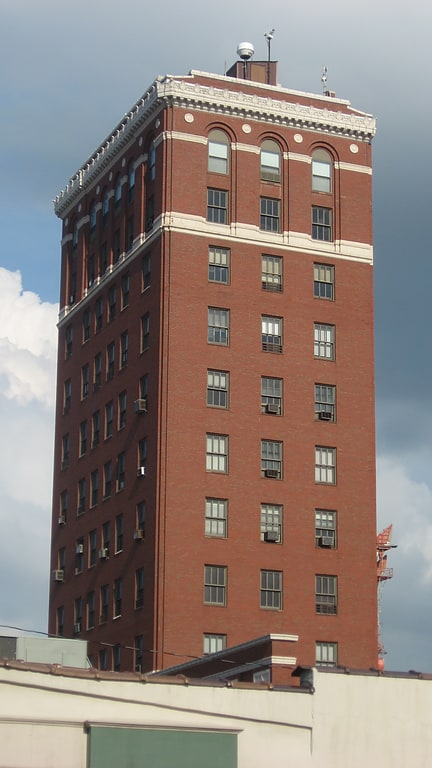
Citizens' Trust Company Building, also known as the Sycamore Building, is a historic office building located at Terre Haute, Vigo County, Indiana. It was designed in 1920 by the local firm of Johnson, Miller & Miller and built in 1921–1922, and is a 12-story, Chicago school style steel frame building sheathed in brick. It features stone and terra cotta detailing and Art Deco style design elements. The building was built to house the main office of the Citizens' Trust Company.
It was listed on the National Register of Historic Places in 1983.[18]